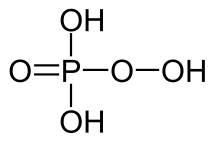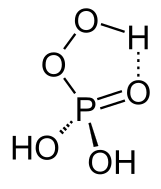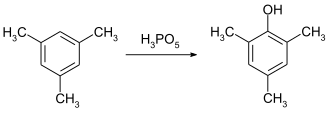Peroxymonophosphoric acid
Peroxymonophosphoric acid (H
3PO
5) is an oxyacid of phosphorus. Its salts are called peroxymonophosphates. It is one of two known peroxyphosphoric acids, along with peroxydiphosphoric acid.
 | |
| Names | |
|---|---|
| IUPAC name
peroxyphosphoric acid | |
| Systematic IUPAC name
(dioxidanido)dihydroxidooxidophosphorus | |
Other names
| |
| Identifiers | |
3D model (JSmol) |
|
| ChEBI | |
| ChEMBL | |
| ChemSpider | |
PubChem CID |
|
CompTox Dashboard (EPA) |
|
| |
| |
| Properties | |
| H3PO5 | |
| Molar mass | 114.00 g/mol |
| Appearance | colorless liquid |
| Solubility | soluble in acetonitrile, dioxane |
| Related compounds | |
Related compounds |
peroxydiphosphoric acid; phosphoric acid |
Except where otherwise noted, data are given for materials in their standard state (at 25 °C [77 °F], 100 kPa). | |
| Infobox references | |
History
Both peroxyphosphoric acids were first synthesized and characterized in 1910 by Julius Schmidlin and Paul Massini via the reaction between phosphorus pentoxide and highly-concentrated aqueous solution of hydrogen peroxide.[1] However, this reaction proceeds very vigorously and is difficult to control. Aside from phosphorus pentoxide, syntheses from metaphosphoric acid and diphosphoric acid were also reported.
A less vigorous method of preparing peroxyphosphoric acid by introducing the inert solvent acetonitrile was described by Gerrit Toennies in 1937. This method was shown to be unsuitable in diethyl ether or isoamyl alcohol.[2]
Preparation
The most widely used method of preparation is the hydrolysis of potassium of lithium peroxydiphosphate in a strong acid such as perchloric acid.[3] The peroxydiphosphate salts can be obtained by electrolysis of their respective phosphate salts.[4]
It can be obtained from the reaction between phosphorus pentoxide and highly-concentrated hydrogen peroxide within an inert solvent like acetonitrile or carbon tetrachloride.[3]
It is also obtained as a mixture with peroxydiphosphoric acid when phosphoric acid is treated with fluorine.[4] The compound is not commercially available and must be prepared as needed.
Properties

Peroxymonophosphoric acid is a colorless, viscous liquid. It is stabilized by an intramolecular hydrogen bond.[5] The compound is a triprotic acid with acid dissociation constants pKa1 = 1.1, pKa2 = 5.5 and pKa3 = 12.8. In aqueous solutions it slowly undergoes hydrolysis to hydrogen peroxide and phosphoric acid.[6]
With excess water, the hydrolysis can be considered pseudo-first order. The half-life for this decomposition is dependent on the pH and temperature, being about 31 hours at 35 °C and 2.5 hours at 61 °C.[6] A solution in acetonitrile also slowly degrades, losing 30% of active oxygen after 26 days of storage at 5 °C.[5] Relatively stable salts can be obtained by neutralization with bases, for example with potassium hydroxide to give the hygroscopic potassium dihydrogenperoxymonophosphate KH2PO5.[4]
Uses
Peroxymonophosphoric acid is used in organic synthesis as an electrophilic reagent for the oxidation of alkenes, alkynes, aromatic compounds and amines. Due to the strongly acidic nature, only relatively acid-stable epoxides can be prepared from alkenes, for example trans-stilbene oxide from trans-stilbene. Less stable epoxides are cleaved or react further; cyclohexene, styrene or α-methylstyrene yield no isolable epoxides. In the cases of styrene and α-methylstyrene, acid-catalyzed alkyl migrations lead instead to the main products phenylacetic acid and 2-phenylpropionic acid, respectively.[7]

The oxidation of diphenylacetylene at room temperature yields benzil, presumably through an oxirene intermediate.[8]

Peroxymonophosphoric acid is an effective reagent for the hydroxylation of aromatic rings. The conversion of mesitylene to mesitol can be achieved at room temperature in less than four hours.[9]

The compound can be used as an effective oxidizing agent for the Baeyer-Villiger oxidation. Substituted acetophenones can be converted to the corresponding phenyl acetates at 30 °C in high yields. The rate is about 100 times higher in comparison to using peroxybenzoic acid.[10]

Tertiary aromatic amines like dimethylaniline are oxidized to the corresponding amine oxide.[11]

Oxidation of THF with peroxymonophosphoric acid gives γ-butyrolactone.[5]
References
- Schmidlin, Julius; Massini, Paul (1910). "Phosphormonopersäure und Überphosphorsäure". Ber. Dtsch. Chem. Ges. 43 (1): 1162–1171. doi:10.1002/cber.191004301195.
- Toennies, Gerrit (1937). "A New Method for the Preparation of Permonophosphoric Acid". J. Am. Chem. Soc. 59 (3): 555–557. doi:10.1021/ja01282a037.
- Zhu, Tian; Chang, Hou-Min; Kadia, John F. (2003). "A New Method for the Preparation of Peroxymonophosphoric Acid". Can. J. Chem. 81 (2): 156–160. doi:10.1139/v03-010.
- Harald, Jakob; Leininger, Stefan; Lehmann, Thomas; Jacobi, Sylvia; Gutewort, Sven (2007). "Peroxo Compounds, Inorganic". Ullmann's Encyclopedia of Industrial Chemistry. Wiley‐VCH Verlag. pp. 310–311. doi:10.1002/14356007.a19_177.pub2. ISBN 9783527306732.
- Rao, A. Somasekar; Mohan, H. Rama (2001). "Monoperoxyphosphoric Acid". Encyclopedia of Reagents for Organic Synthesis. John Wiley & Sons. doi:10.1002/047084289X.rm287m. ISBN 9780470842898.
- Battaglia, Charles J.; Edwards, John O. (1965). "The Dissociation Constants and the Kinetics of Hydrolysis of Peroxymonophosphoric Acid". Inorg. Chem. 4 (4): 552–558. doi:10.1021/ic50026a024.
- Ogata, Yoshiro; Tomizawa, Kohtaro; Ikeda, Toshiyuki (1979). "Oxidation of trans-Stilbene with Peroxymonophosphoric Acid". J. Org. Chem. 44 (14): 2362–2364. doi:10.1021/jo01328a006.
- Ogata, Yoshiro; Sawaki, Yasuhiko; Ohno, Takashi (1982). "Mechanism for Oxidation of Phenylacetylenes with Peroxymonophosphoric acid. Oxirene as an Intermediate Inconvertible to Ketocarbene". J. Am. Chem. Soc. 104 (1): 216–219.
- Ogata, Yoshiro; Sawaki, Yasuhiko; Tomizawa, Kohtaro; Ohno, Takashi (1981). "Aromatic Hydroxylation with Peroxymonophosphoric Acid". Tetrahedron. 37 (8): 1485–1486. doi:10.1016/S0040-4020(01)92087-3.
- Ogata, Yoshiro; Tomizawa, Kohtaro; Ikeda, Toshiyuki (1978). "Kinetics of the Baeyer-Villiger Reaction of Acetophenones with Permonophosphoric Acid". J. Org. Chem. 43 (12): 2417–2419. doi:10.1021/jo00406a025.
- Ogata, Yoshiro; Tomizawa, Kohtaro; Morikawa, Takashi (1979). "Kinetics of the Peroxymonophosphoric Acid Oxidation of Aromatic Amines". J. Org. Chem. 44 (3): 352–355.